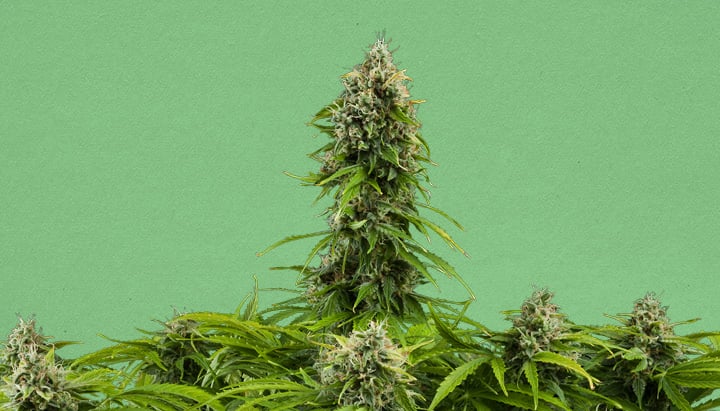.

Jack Herer: A Look at the Hemperor's History and Legacy
Jack Herer was one of the significant figures of the modern cannabis movement. This article looks back on the man's life and his contributions to the cannabis industry.
If you’re a long-time herb lover, you’re likely familiar with the Jack Herer strain. You’re well-acquainted with its citrus flavour and the cerebral elevation that comes with it.
Especially if you’re a sativa connoisseur, you’ve likely made this beloved strain your trusty companion on those dreary, dragging mornings. When you need that boost of creativity, it is there to care for you.
But many of you probably aren’t familiar with the man whom this strain is named after. A lot of you are likely unaware of his accomplishments, contributions, and what he stood for.
Whether you know of him or not, let this article be an homage and introduction to the man, the legend, the late “Hemperor”—Jack Herer.
Contents:
Who Is Jack Herer?
Jack Herer has been described as a “Front Line Freedom Fighter” for cannabis. He did, after all, rise to prominence because of his activism for marijuana decriminalisation and legalization. Herer also fought for the expansion of hemp for industrial purposes.


But, as a youngster, Herer wasn’t expected to be the type who’d grow up to be a cannabis activist.
Born in 1939 to a conservative Jewish family in Buffalo, New York, Jack was as straight-edged as they came. He was enlisted in the US Army at 17 and was an ardent supporter of the Vietnam war in his early adult years.
As a “Goldwater Republican”, Herer was vocal about his disapproval of anti-war protesters in the 60s. He condemned those who opposed the government’s military efforts, and went as far as labelling them “un-American”. By the time he hit his 20s, Herer was already married with three children.
At the time, Jack didn’t perceive cannabis in a favourable light, either. Growing up at the height of Reefer Madness propaganda, he admitted to developing a deep fear of the herb. Herer also wasn’t a big fan of the hippie movement, and eventually developed a dislike by association.
How Did Herer’s Relationship With Weed Begin?
Jack ended up getting divorced in his 30s, but it didn’t take long for him to find new love. And, as it turned out, this new girlfriend would change his life forever.
As the couple was hanging out one night, the woman asked Jack if he’d ever smoked marijuana. He of course gave “no” as an answer, to which the woman responded, “I think you should”.
Safe to say, Jack was enchanted by the magic herb. His eyes were opened to an entirely new perspective. He described the experience as having sensations he didn’t know human beings could possibly feel.
His outlook about the war also changed because of that experience. As he said in an interview from his documentary Jack Herer: Emperor of Hemp, he began to realise the protesters’ words and how they “had real meanings and textures”.
It was then that Jack decided to make something out of his newfound fascination for cannabis. In 1973, he co-authored a cartoon book entitled Grass: Great Revolutionary American Standard System, with friend Al Emmanuel.
The duo branded it “the official guide” for assessing marijuana quality. They also had a rating system, with 1 as the lowest and 10 as the highest. The book garnered a cult following and sold around 30,000 copies underground. It was the turning point of Herer’s career, as it turned him into a respected figure in the cannabis realm.
Royal Jack Auto
|
|
Jack Herer x Ruderalis |
|
|
350 - 400 gr/m2 |
|
|
40 - 80 cm |
|
|
7 - 8 weeks |
|
|
THC: 16% |
|
|
Sativa 40% Indica 30% Ruderalis 30% |
|
|
70 - 120 gr/plant |
|
|
60 - 80 cm |
|
|
11 - 12 weeks after sprouting |
|
|
Creative, Motivating |
A “Hemperor” Is Born
As his cannabis superstardom grew further, Herer continued to take things up a notch. And while he did begin to fight against anti-marijuana propaganda, hemp remained his foremost passion.
He tried to partner up with fellow activists from the National Organisation for the Reform of Marijuana Laws (NORML), but to no avail. They were more interested in reforming cannabis laws and did not show the same passion for hemp.
Herer eventually found an ally in Ed Adair, aka “Captain Ed”. A cannabis reformist and headshop owner in Los Angeles, Adair worked with Herer to create a pledge in support of their marijuana advocacy. The duo gathered a large backing through thousands of signatures in a short amount of time.
Both Herer and Adair looked at cannabis-related incarcerations as a “great injustice” that they were willing to fight head-on. In 1979, the two opened the very first hemp shop in the United States, located in Venice Beach, California.
Herer viewed hemp as a valuable life force. He saw its great potential as a primary ingredient in manufacturing vital resources like clothing, paper, even clean fuel. For him, it was the answer to the world’s biggest problems, such as deforestation, global warming, and pollution.
The Emperor Wears No Clothes: Herer’s Crowning Achievement
By the 1980s, the American government ramped up its crackdown on cannabis. Its zero-tolerance policies against the magic herb were at an all-time high.
As one of the major marijuana figureheads at the time, Herer was an expected target of law enforcement. In 1981, he was arrested in California for trespassing on federal property. At the time, he was collecting signatures for a ballot initiative in the state.


After refusing to pay the $5 fine, Herer was handed a 14-day sentence in federal prison in 1983. It was during this time that he wrote his best-selling book The Emperor Wears No Clothes, which was published two years later.
Rated a number one all-time best-seller, the book echoed Herer’s main ideologies about hemp and cannabis; that the former is a vital renewable resource, which makes the latter equally essential.
The book also touched on many of the heated topics surrounding cannabis, like how it’s a plausible “gateway drug” to harder substances. For Herer, the gateway argument was a mere “social theory”.
He pointed out a lack of stable claims to prove marijuana’s pharmacological qualities as “a risk factor for progression” to much more dangerous substances. As Herer interpreted, “The real gateway to harder drugs is prohibition”.
Upon his release from prison, Herer moved to Portland, Oregon. In 1987, he opened up another headshop called The Third Eye. Located in the city’s Hawthorne district, it’s become a destination for cannabis-lovers, both local and tourist.
Around this time, Herer also had political aspirations. He ran for president twice, in 1988 and 1992, under the now-defunct Grassroots Party.
Herer’s Later Years and Death
Herer carried on with his cannabis activism throughout the years. In 1990, he had one of the busiest weeks of his life, addressing a total of 60 rallies in 48 different places.
Herer got married three more times. His most recent wife, Jeannie Hawkins, whom he married in 2000, was by his side as he continued to champion his cause. But that hectic life on the road also took a toll on his physical health.
In 2000, Herer suffered a heart attack and a stroke during a hemp festival near Eugene, Oregon. For a brief period, he had a difficult time speaking and moving the right side of his body.
But Herer wasn’t giving up that easily. After going through a gruelling recovery process, he was able to get back up on his feet. He did, however, credit his recuperation to the daily use of highly concentrated cannabis oil and the regular use of psychoactive mushrooms.
Unfortunately, Herer suffered another heart attack in September 2009 at the Hempstalk Festival in Portland. He was hit harder this time around and left unable to properly communicate.
On April 15, 2010, Jack Herer, one of the most celebrated heroes of cannabis activism, died from the complications of his second heart attack. He was 70 years old.
The Jack Herer Legacy
We can say for sure that Jack Herer left behind a rich legacy that is remembered in many ways. In some ways for the worse, and some ways for the better.
A legacy of Controversy
Although he accomplished many feats that revolutionised the world of cannabis as both a culture and an industry, he wasn’t without his controversies, enemies and setbacks. One of his biggest enemies, and often most considerable criticism from friends and opponents alike, was himself.
Jack Herer was often described as a man with such passion for the cause that he succumbed to zealously, absolutism and embellishment. Although one of the most influential people in the fight for legalisation, his militancy would often rub people up the wrong way, making it harder to convince more moderate parties with facts alone.
Even with a platform based on fact, Jack Herer was also often accused of embellishment, and romanticising what hemp and cannabis were capable of. For example, Dr. Hayo M.G. van der Werf, a renowned hemp expert, criticised Herer for claims he made about hemp hurds—a valuable industrial resource.
According to Herer, the hemp hurd cellulose content sat somewhere between 60-70%, inflating its value, where in reality, it is thought to be between 32-38%.
Of course, it is pretty feasible this was not an intentional embellishment. Hemp science was still developing, and it was an easy mistake to make. However, this inability to avoid doing so did Herer’s cause a disservice.
A legacy of progression and positivity
Not all is doom and gloom about the legacy left by this titan. In fact, quite the opposite. He is a titan of the cannabis legalisation movement for a reason.
Jack Herer died with his boots on, and as his cause was gathering steam. At the time of his death, 14 states and the District of Columbia had made medical marijuana legal, largely thanks to his unbending will and passion for spreading the truth about cannabis.
He also authored the Emperor Wears no Clothes with the help of Paul Stanford, founder of The Hemp and Cannabis Foundation, an organisation that has helped over 250,000 people gain access to legal medical cannabis.
Despite criticism thrown his way, Herer was a widely respected, larger-than-life figure among cannabis lovers worldwide. So much so that cultivators created a strain in his honour, inducted him into the counterculture hall of fame in 2013, and hold a cannabis award event in his name.
The Jack Herer strain, created in the mid-’90s in the Netherlands, is still seen as one of the all-time classics, enjoyed by enthusiasts and used as a base for breeding new hybrids worldwide. It is especially cherished for its potency and CBG content, ranging from 0.2-2.2%


As a smoke, the Jack Herer strain is a perfect embodiment of the man’s character. A few hits of this herb will leave you with a clear head and a sound mind, just like how the man approached his beloved cause. As a testament, the strain has over 14 awards to its name.
Whatever you have to say about Jack Herer, one thing is clear: we would not be where we are today with the legalisation movement without him. His passion may have intimidated people, but it is the reason so many were able to see the truth. His ability to bring together all the information on cannabis and present it in an easy to understand, approachable way helped remove the taboo and inspire a generation of activists. For that, we will always be thankful.
Rest easy, Hemperor.







































